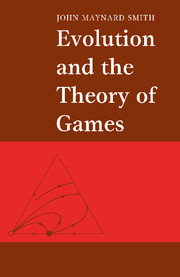Book contents
- Frontmatter
- Contents
- Preface
- 1 Introduction
- 2 The basic model
- 3 The war of attrition
- 4 Games with genetic models
- 5 Learning the ESS
- 6 Mixed strategies – I. A classification of mechanisms
- 7 Mixed strategies – II. Examples
- 8 Asymmetric games – I. Ownership
- 9 Asymmetric games – II. A classification, and some illustrative examples
- 10 Asymmetric games – III. Sex and generation games
- 11 Life history strategies and the size game
- 12 Honesty, bargaining and commitment
- 13 The evolution of cooperation
- 14 Postscript
- Appendixes
- Explanation of main terms
- References
- Subject index
- Author index
4 - Games with genetic models
Published online by Cambridge University Press: 05 June 2012
- Frontmatter
- Contents
- Preface
- 1 Introduction
- 2 The basic model
- 3 The war of attrition
- 4 Games with genetic models
- 5 Learning the ESS
- 6 Mixed strategies – I. A classification of mechanisms
- 7 Mixed strategies – II. Examples
- 8 Asymmetric games – I. Ownership
- 9 Asymmetric games – II. A classification, and some illustrative examples
- 10 Asymmetric games – III. Sex and generation games
- 11 Life history strategies and the size game
- 12 Honesty, bargaining and commitment
- 13 The evolution of cooperation
- 14 Postscript
- Appendixes
- Explanation of main terms
- References
- Subject index
- Author index
Summary
The genetic assumption which underlies the standard ESS conditions of equation (2.4a,b), or (2.9) for the extended model, is that of parthenogenetic inheritance. Most populations of interest have sexual diploid inheritance. In many cases this does not matter. If the phenotype, pure or mixed, which satisfies the standard conditions is one which can be produced by a genetic homozygote, then a sexual population with that genotype will be stable against invasion by any mutant. Suppose, however, the ESS cannot be produced by a genetic homozygote. The question then arises of whether a genetically polymorphic population can generate the appropriate strategies in the ESS proportions, and if so whether such a population will be stable. Clearly the answer cannot always be yes. For example, suppose the three pure strategies I, J and K must be present in equal frequencies at an ESS. If they were produced, respectively, by the three genotypes AA, Aa and aa at a locus, then, in a random-mating population, there is no way this could happen. This problem is discussed, for a simple genetic model, in section A. It is treated more generally by Eshel (1981b).
An explicit genetic model may also be needed when the phenotypic trait of interest is itself concerned with the process of sexual reproduction, so that appropriate fitnesses can only be calculated for a sexual model.
- Type
- Chapter
- Information
- Evolution and the Theory of Games , pp. 40 - 53Publisher: Cambridge University PressPrint publication year: 1982



